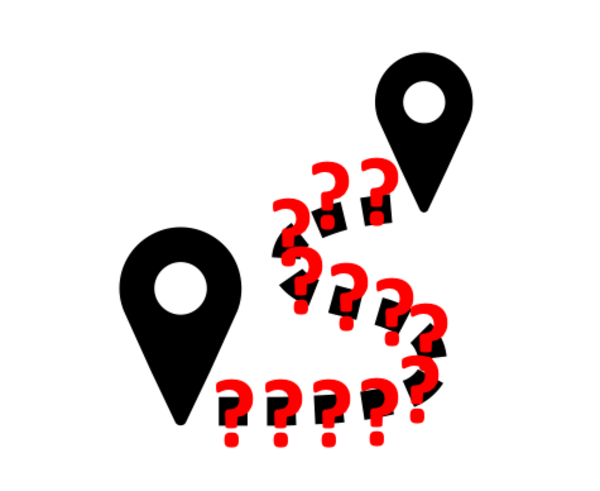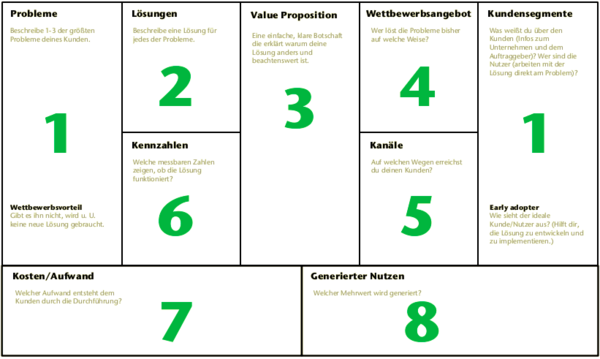Know-How #1
Lean Canvas Part I - Business Modelling during the Planning Phase
Google Maps for your business modell

What is the benefit of Google Maps during trip planning? It puts the destination in relation to a starting position and describes the most efficient route. The requirements in the planning phase of the start-up are similar to this. This is exactly where the Lean Canvas helps you: Starting with the problems or needs of the stakeholders (customers), a solution is outlined that shows a corresponding benefit. This benefit is to be understood as the value proposition to the customer and is omnipresent (even beyond the planning stage). Successively, other relevant content is added. So the "foundation map" is drawn and the project can start.
The benefit therefore lies in the inclusion of all relevant stakeholders, the focus on the customer benefit and the holistic expansion with additional, relevant aspects.
Tip: Download the Lean Canvas to fill it out directly in our download area at "Methods & Tools"!
Origin
Before going into detail about the individual components of the Lean Canvas, a short excursion into the origins of the tool should be undertaken. In his 2010 book "Running Lean", Ash Maurya describes the Lean Canvas as a "one-page business plan". Its primary focus is on finding customer problems worth solving. Fittingly, he promotes the model with the saying, "Life's too short to build something nobody wants!"

Planning process
The Lean Canvas is composed of nine individual blocks. The order in which these are run through varies depending on the corresponding requirements. For initial orientation, however, I would like to present my idea of an "ideal" process here. At the beginning it should be noted that not necessarily only one canvas is created per start-up project. It may well be that due to different user and customer groups, several different canvases have to be created.
Customer segments
Customers and users
"Who are the customers and users of the results?"
This is where the corresponding stakeholder groups are deposited. But what is the difference between customers and users? Customers and users do not differ in every case. However, the criterion of payment can be used to differentiate. Customers pay for the product. Ebay lets bidders buy for free. The seller, on the other hand, pays a percentage discount. In this case, the bidder is the user and the seller is the customer. It is important to understand that the stakeholders, customers and users, initially provide the problem and later on are the most important source of feedback and also for the further development of the project.
Early Adopter
The early adopter is the ideal customer or user. He is someone who is willing to give feedback and test your ideas without much hesitation. He already has suitable prior knowledge and understands your solution approach better than other customers and users.
Problems
"Discuss and chase down your customers 1-3 biggest problems!"
This section is at least as important as finding customers and users yourself. This is the foundation for any product, because without a problem, there is no reason to design a solution. Depending on the degree of subdivision into customers and users, it is also important to make the appropriate subdivision here. This way, the right problems can be assigned to the right stakeholder groups.
Competitive Advantage
"Something that makes it hard for others to copy the solution!"
Why is the targeted product better than a potential competitor's product? What are you striving for that existing alternatives don't already deliver? This is where further activity in the start-up starts.
Solutions
"Describe a solution to each of the problems."
Now it's about the real work in the project, generating a solution. How do you solve the problems of customers and users?
Value Proposition.
"A simple, clear message explaining why your solution is different and worthy of attention!"
This is the central aspect of the Lean Canvas and therefore of the start-up. The real goal. This message summarizes in simple terms what the customer/user can expect from your company. It's effectively the answer to the question, "Why should I care about this product?"
The easiest way to get closer to the concept is to use an example. For example, Airbnb uses the message, "Book unique accommodations and experience the city like a local." The solution is first explained ("Book unique accommodations"), and then the second part highlights the added value for the user ("... experience the city like a local"). It is immediately clear to the reader what they get out of using it. The question why to use Airbnb is answered.
Competitive bid
This field is crucial and is particularly related to competitive advantage. The question that should come up as part of any startup is, "Are there alternatives to the product you're targeting?" Especially those that can be accomplished with less time and cost are relevant at this point.
Key figures
"What measurable numbers will show whether or not the solution works?"
At this point, the project is quantified and made measurable. With the help of suitable key figures, piece by piece should be validated and the result made reproducible. Possible questions in the metrics determination are:
Does the customer/user actually have the problem I assumed?
Does my solution work/add value?
Is the intended benefit achieved?
How well does which channel work?
Are the costs too high?
and many more
These questions are the starting point. From here on, the question must be answered: "How can I make this measurable?"
Channels
"How do you reach your customers?"
How are customers reached? What are the different touchpoints (e.g. pre-sale, at-sale, post-sale)? The main focus is on the development of the product starting from the customer/user. The feedback required for this is obtained via the corresponding channels. The channels also play a decisive role in determining the key figures. For example, if one wants to set up a blog, the following question arises: "How can I be sure whether my users actually get added value from it?" The answer is of crucial importance for the further course of action. So, a suitable channel has to be found to survey the users. Above that, a metric related to the channel is needed to measure success. In this example, the channel could be the newsletter with a link to an initial demo blog page. The click through rate then provides information about user behavior.
Cost
"What are the costs associated with implementation?"
Here are all the costs that will be incurred in the further course of the start-up, for example:
Personnel costs
Training costs
Development costs
Marketing
Material costs
and much more
Generated benefit
"What value is generated?"
At this point, the Lean Canvas summarizes the revenue generated by the product. This means that the corresponding revenue generation opportunities meet the pricing models at this point.
Along with costs, a first look at profitability can then be taken. For example, the revenue per customer can be compared with the direct costs per customer. This way you can estimate on one hand how many customers are needed to cover fixed costs. On the other hand, you can forecast your profit in this way.
You can start right now and download the Lean Canvas from our download area at "Methods & Tools"!
The second part of the Lean Canvas article is about the implementation of your project and how the Lean Canvas can support you here.
